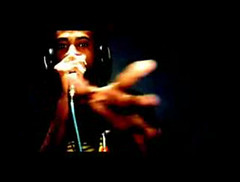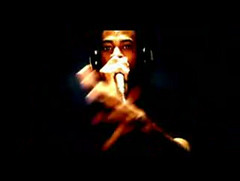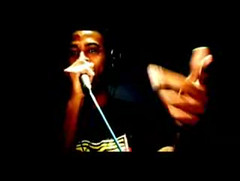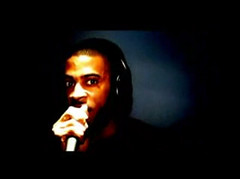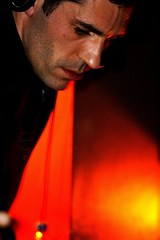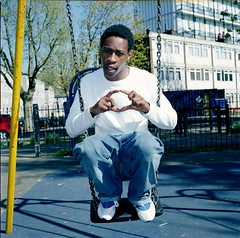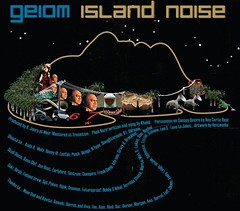
In a follow up to my Geiom interview, I have a specially commissioned "influences" mix by Geiom to share. With his album "Island Noise" out now (check "Phlei Nasir", it's nuts!), Geiom has kindly taken the time to assemble a diverse mix and describe what each track means to him.
DOWNLOAD the Geiomix here
Joao Gilberto – Manhã de Carnaval – 1959
“From the film Black Orpheus – this is what got me started on Brazilian music – well bossa nova at least. Bossa nova always seemed childlike at first but some of the main characters were actually quite debauched.”
Kishore kumar – Koi haseena - 1975
“Demonstrates a very fertile period in Indian pop – no fear of using funk guitars or mad synths in a tune. Sadly these days the western influence often just means a ‘dance’ beat or a rap section in English. It’s from one of the most popular Indian films ever, Sholay. I heard this a lot when I was growing up.”
Raymond Scott – Backwards overload -1968
“Genius electronic sound art from an era when only a few people like Mr Scott could make this stuff – Using instruments the size of a car, specially designed and built by himself and Robert Moog.”
Bjork – Scatterheart – 2000
“Truly visionary artist who always stays ahead of the game. From the film Dancer in the Dark which I found a bit crap (!) but also very emotional.”
Sweet Exorcist – Clonk - 1990
“Weird bass music from Richard H Kirk, who was half of legendary synth duo Cabaret Voltaire, and pioneering Sheffield producer DJ Parrot. The album ‘CCEP’ is a tripped out masterpiece. Sounds outrageous on a good system.”
4 Hero – No sleep raver - 1991
“Very unusual rave era tune that sounds more latin than ‘ardcore…4 Hero on some next level tip. The sample is from a wicked tune called ‘Friday Night Saturday Morning’ by The Specials. Terry Hall always makes interesting music – his more recent stuff with Mushtaq is top.”
Kosmik Kommando - ? - 1993
“All the things I like about acid music – relentless weaving synths expertly tweaked. Makes me think about strobe lights and sunrise.”
Plaid – Angry dolphin - 1995
“Great example of how you can mangle beats but still retain the funk. Totally inspirational producers.”
Sun Ra – Planetary search - 1980
“Crazed keyboard action from the outer space master.”
The Upsetter – Bird in hand - 1978
“Reggae likes to have a go at every style and this Lee Scratch Perry tune cleverly blends devotional style Indian melody over a sick dubbed out riddim. “
Goofy – Pack bus dem - 2000
“Pure joke tune – classic beat with the hilarious Goofy complaining about overcrowded Jamaican public transport. I love having ragga tunes on 7” vinyl – it’s a shame its dying out.”
Biz Markie – Just a friend - 1989
“Everyone loves this tune – its stupid but great ! We get treated to the inimitable Biz singing over a cheesy piano riff in this gently rocking hip hop classic.”
Paris – The devil made me do it - 1989
“From a big album with menacing lyrics that actually have some meaning, which can be a bit lacking in Hip Hop these days. Paris got in a lot of trouble for his politics but is still on it. Sick reversed backing track.”
Microstoria – Endless summer - 2000
“I became immersed in very minimal glitchy music around this period and these guys were maybe the best at it. I think one of this duo started out by damaging CD’s and sampling the results. They went on to turn the idea into an artform in its own right.”
Fela Kuti and Ginger Baker – Ye ye de smell - 1971
“The length of most Fela Kuti tracks is crazy ! – but the band is always tight and constantly inventive. I love afrobeat as a live experience but this is the next best thing. Pure energy as the king of African funk meets up with master UK drummer Ginger Baker in Nigeria and turns out a timeless album.”
Ennio Morricone – Esplicitamente Sospeso - 1973
“This is proper scary. We saw Morricone conducting a special concert on his 75th birthday - he is a badman. Despite being best known for epic catchy film themes this demonstrates that Mr Morricone is just as deadly with abstract dronescapes.”
Joy Division – Passover - 1980
“I love the way that Joy Division are bleak but still really tender. The production is cold and metallic and Ian Curtis’s voice is kind of robotic and it all combines to evoke something unique.”
Mazzy Star – All your sisters – 1996
“The singer in Mazzy Star (Hope Sandoval) has one of my favourite voices. Lush track.”
Kraftwerk – Ruckzuck - 1970
“From before Kratwerk went totally electro. I remember stuff like Tour de France from breakdancing as a kid but I discovered this side of them much later. Sounds almost like a live band with some tight drumming and mashed up flute/synth riff.”
Stevie Wonder – Evil - 1972
“Stevie in his best era plays every single instrument by himself to produce a nostalgic tune packed out with amazing vintage keyboards.”
Timmy Thomas – Why can’t we live together ? - 1972
“From an odd lo-fi album by a guy who only plays Hammond organ and drum machine for every track - it sounds like its recorded in black and white but the vocals and melodies are pure sweetness.”
The Stylistics – People make the world go round – 1972
“I got into this backwards – there is a cover of it on a Carl Craig album which I loved, then I discovered the original. Slick instrumentation from the days when pop music had full horn sections and stuff.”
Read the full Geiom interview here


